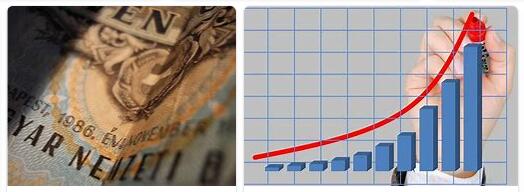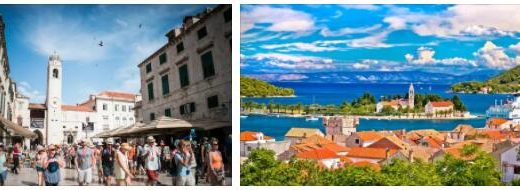Hungary Economic Conditions
The Hungarian economy was among the first within the Soviet bloc to try to achieve a certain liberalization with the 1968 reform, which was based on the establishment of a system which provided, at the same time, for the coexistence of elements typical of the ‘socialist economy and others of a semi-liberal economy: companies could establish production objectives, trade abroad, reinvest the profits made, but the larger investments were implemented following the rules of rigid centralized planning. However, difficulties in the balance of payments and the shifting of substantial financial resources towards inefficient companies have, over time, determined a situation of crisis. Since 1990, new and more radical reforms have been implemented by the new political groups in power, partly in the line already anticipated in 1988, the year in which the possibility of setting up joint-stock companies was introduced, with the privatization of many activities in the service and agricultural sectors. In 1994 the State accelerated the process of liberalizing the economy, launching a series of measures aimed at attracting foreign investors (currency devaluation, a much more decisive privatization plan than in the past, cuts in social spending and a increase in the tax burden). In the second half of the 1990s, as a result of these measures, the Hungarian economy resumed growth, exports and foreign investments increased steadily, while the unemployment rate gradually decreased until reaching values similar to the European average.. Such positive results have meant that the Hungary rejoined the group of countries admitted to the European Union in 2004. Subsequently, for reasons due both to the recession phenomena of the international economic context and to intrinsic factors of weakness of the national economy, it was necessary to adopt further measures of austerity, in order to reduce the budget deficit.
● Just over half of the country’s land area is arable, while just under 20% is covered by woods and 15% by meadows and pastures. Agriculture contributes 3.4% to GDP and employs 4.5% of the workforce (2009 data). The main crops are represented by cereals (mainly wheat and corn), potatoes and sugar beets. Widespread in the western and northern hilly regions, viticulture feeds the production and export of fine wines (Tokaj is known). Other important products are oil plants (rapeseed, sunflower, soybeans), tobacco, flax, hemp and vegetables. The breeding, practiced extensively in the pastures ofpusztaand mainly in stallive form in Alföld, it constitutes an important economic item. The zootechnical patrimony mainly consists of birds, pigs and sheep, while the traditional one of cattle appears in decline. The exploitation of the forests guarantees an average production of 6 million m3 of wood per year.
● Mineral resources primarily include lignite, the main deposits of which are located on the southern slope of the Mátra Mountains and, W of the Danube, near Tatabánya. Oil and natural gas fields are present in the southwestern part of the country (Nagylengyel) and E of the Tisza, but the yields are far from making the Hungary energy self-sufficient. Bauxite (in the Selva Baronia), coal (in the Pécs basin), manganese and uranium are also extracted. For Hungary 2017, please check mathgeneral.com.
● The industrial sector (34, 3% of GDP and 32.1% of the workforce) has developed, starting from the 1950s, through a rapid and forced growth of heavy industry, according to the dictates of a development model that did not take into account energy poverty and of raw materials of the country. Since the 1960s, on the other hand, sectors such as precision mechanics and electronics have been privileged. The food and beverage industry and the tobacco industry have a long tradition. The chemical industries are located W of the Danube in Berhida, Győr, Zalaegerszeg, Pécs and, in the northern and eastern part of the Tisza basin, in Malyi, Tiszapalkonya, Tiszavasváry, Debrecen. Mechanical industries, aimed at the production of commercial vehicles and railway material, are based in Budapest, Győr, Miskolc, Pécs. Electronics has its main center in Székesfehérvár.
● The service sector (62.4% of GDP and 63.4% of the workforce) experienced a strong expansion in the transition to the new economic system. Commercial activities are of particular importance, both those linked to small retail businesses and those represented by foreign large-scale distribution companies. Tourism has also experienced a notable increase, providing increasing job opportunities; among the most popular destinations, Budapest and Lake Balaton. The development of the advanced tertiary sector is also promising: huge resources have been allocated by the government for the enhancement of research and for the construction of science parks. The Hungary maintains the majority of commercial exchanges with EU countries (in particular Germany, Italy, Romania, Austria and France). For imports, Russia is also an important partnerand China. As far as exported products are concerned, electrical and electronic equipment, machinery and means of transport stand out, followed by products in plastic and precision mechanics, pharmaceuticals, clothing and food; among imports, machinery and industrial and food raw materials prevail.
● As far as communication routes are concerned (2005), the road system stretches over almost 160,000 km (of which over 600 km of motorways), the rail system over 8057 km, the inland waterway system over 1622 km. The city of Budapest is involved in a European communication plan designed to connect western and central Europe with Ukraine through a system of highways and railways connected with the port of Trieste.












